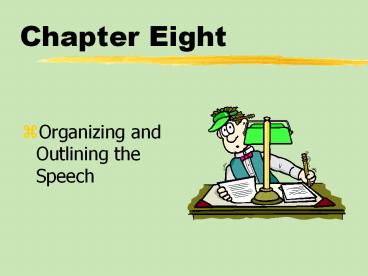Chapter Eight - PowerPoint PPT Presentation
1 / 27
Title:
Chapter Eight
Description:
Chapter Eight Organizing and Outlining the Speech Chapter Eight Table of Contents Main Points, Supporting Points, and Transitions Organizational Arrangements ... – PowerPoint PPT presentation
Number of Views:152
Avg rating:3.0/5.0
Title: Chapter Eight
1
Chapter Eight
- Organizing and Outlining the Speech
2
Chapter Eight
- Table of Contents
- Main Points, Supporting Points, and Transitions
- Organizational Arrangements
- Outlining Speech Material
3
Main Points, Supporting Points, and Transitions
- A Speech structure is composed of an
introduction, a body, and a conclusion - The Introduction establishes the purpose of the
speech, and shows its relevance to the audience - The body of the speech presents main points that
are intended to fulfill the speech purpose - The conclusion ties the purpose and main points
together
4
Main Points, Supporting Points,
TransitionsMain points Making the Claim
- Main Points
- Used to express the key ideas and major themes of
a speech used to make statements or claims in
support of the thesis
5
Main Points, Supporting Points,
TransitionsGuideposts
- You can use the specific purpose and the thesis
statement as guideposts to help generate the main
points of your speech
6
Main Points, Supporting Points,
TransitionsNumber of Main Points
- Depending on the topic, the amount of material to
be covered, and the length of the speech, three
main points should be sufficient for almost any
speech - Listeners can more easily recall points made at
the beginning and end of a speech
7
Main Points, Supporting Points,
TransitionsForm of Main Points
- A main point should not introduce more than one
idea. If it does, it should be split into two or
more main points
8
Main Points, Supporting Points,
TransitionsForm of Main Points
- Main points should be stated in parallel form
- Parallel Form
- Involves stating main points in similar
grammatical form and style
9
Main Points, Supporting Points,
TransitionsSupporting Points
- Supporting Points
- Represent the material or evidence gathered to
justify the main points - Main points are enumerated with upper-case Roman
numerals, supporting points with capital letters,
and third level points with Arabic numerals
10
Main Points, Supporting Points,
TransitionsTransitions Giving Direction
- Transitions
- Words, phrases, or sentences that tie the speech
ideas together and enable the speaker to move
smoothly from one point to the next
- A transition statement can be a rhetorical
question or a restatement of the previous point,
and a forecast of the next point
11
Main Points, Supporting Points,
TransitionsOrganizing The Points
- A well-organized speech is characterized by
unity, coherence, and balance
12
Main Points, Supporting Points,
TransitionsOrganizing The Points
- Unity
- A unified speech contains only those points that
are implied by the purpose and thesis statements - Coherence
- Clarity and consistency a coherent speech is
logically organized
13
Main Points, Supporting Points,
TransitionsOrganizing The Points
- Subordination and coordination
- The logical placement of ideas relative to their
importance to one another - Balance
- Balance involves giving appropriate emphasis or
weight to each part of the speech relative to the
other parts and to the theme
14
Organizational Arrangements
- Once a speaker has determined what the main and
supporting points will be, he/she can proceed to
organize them according to one or a combination
of patterns
15
Organizational ArrangementsTopical Arrangements
- A topical pattern of arrangement is used when
each of the main points of a topic is of
relatively equal importance, and when these
points can be presented in any order relative to
the other main points without changing the
message
16
Organizational ArrangementsChronological
Arrangements
- The chronological pattern of arrangement is used
to reflect the natural or sequential order of the
main points
17
Organizational ArrangementsSpatial Arrangements
- Spatial or geographical patterns of arrangement
are used when main points are arranged in order
of their physical proximity or direction relative
to each other
18
Organizational ArrangementsCausal Arrangements
- A causal pattern of arrangement is used when the
main points of the speech compare something known
to be a cause to its effects
19
Organizational ArrangementsProblem-Solution
Arrangements
- A problem-solution pattern of arrangement is used
when the main points are organized to demonstrate
the nature and significance of a problem and then
to provide justification for a proposed solution
20
Outlining Speech Material
- Outlines are visual representations of the basic
structure of the speech, revealing any weakness
in the logical ordering of points
21
Outlining Speech MaterialWorking Outlines
- Working outlines are used to refine and finalize
the specific purpose statement, brainstorm main
points, and develop supporting points to
substantiate them
22
Outlining Speech MaterialSpeaking Outlines
- A speaking outline is used when practicing and
actually presenting a speech
23
Outlining Speech MaterialSentence Outlines
- A sentence outline states each main and
supporting point as a full declarative sentence - These sentences are usually stated precisely the
way the speaker wants to express the idea
24
Outlining Speech MaterialPhrase Outlines
- Phrase outlines are used to express each main and
supporting point with a partial construction of
the sentence form
25
Outlining Speech MaterialKeyword Outlines
- Keyword outlines convey each main and supporting
point with the smallest possible units of
understanding, such as a single word or very
brief phrase
26
Outlining Speech MaterialBenefits/Drawbacks of
Outlines
- Sentence outlines reduce the amount of eye
contact the speaker has with the audience - Phrase outlines work best when a speech is
thoroughly rehearsed - Keyword outlines are easier to handle and follow
than are sentence or phrase outlines
27
Outlining Speech MaterialOutlines and Speech
Delivery
- The type of outline you select will affect how
well you deliver your speech - Weigh the advantages and disadvantages of each
style of outline, and select the appropriate one
for your speech































